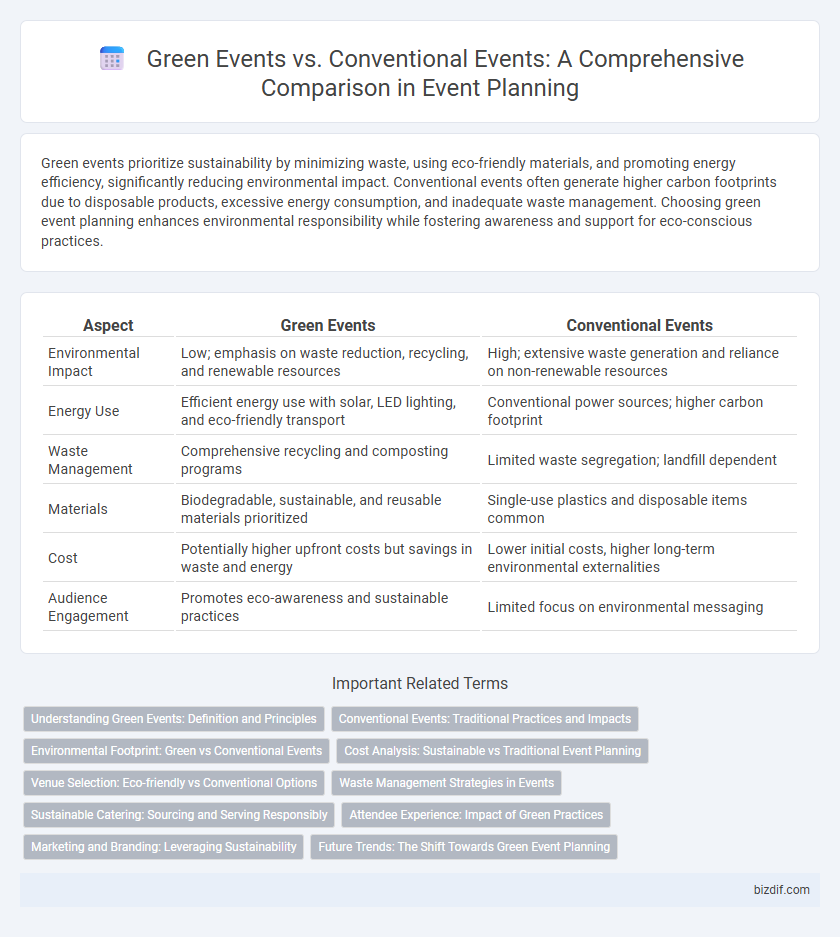Green events prioritize sustainability by minimizing waste, using eco-friendly materials, and promoting energy efficiency, significantly reducing environmental impact. Conventional events often generate higher carbon footprints due to disposable products, excessive energy consumption, and inadequate waste management. Choosing green event planning enhances environmental responsibility while fostering awareness and support for eco-conscious practices.
Table of Comparison
| Aspect | Green Events | Conventional Events |
|---|---|---|
| Environmental Impact | Low; emphasis on waste reduction, recycling, and renewable resources | High; extensive waste generation and reliance on non-renewable resources |
| Energy Use | Efficient energy use with solar, LED lighting, and eco-friendly transport | Conventional power sources; higher carbon footprint |
| Waste Management | Comprehensive recycling and composting programs | Limited waste segregation; landfill dependent |
| Materials | Biodegradable, sustainable, and reusable materials prioritized | Single-use plastics and disposable items common |
| Cost | Potentially higher upfront costs but savings in waste and energy | Lower initial costs, higher long-term environmental externalities |
| Audience Engagement | Promotes eco-awareness and sustainable practices | Limited focus on environmental messaging |
Understanding Green Events: Definition and Principles
Green events prioritize sustainability by minimizing environmental impact through waste reduction, energy efficiency, and eco-friendly materials. These events implement principles such as carbon footprint reduction, resource conservation, and social responsibility to create a positive ecological and community footprint. Understanding green event guidelines helps planners design eco-conscious experiences that support long-term environmental health.
Conventional Events: Traditional Practices and Impacts
Conventional events typically rely on single-use materials, extensive energy consumption, and significant waste generation, leading to a large carbon footprint. Traditional practices often include printed programs, plastic decorations, and disposable dining ware, which contribute to environmental degradation. The impact of these events involves increased greenhouse gas emissions, resource depletion, and substantial landfill waste.
Environmental Footprint: Green vs Conventional Events
Green events significantly reduce environmental footprint by utilizing sustainable materials, minimizing waste, and conserving energy compared to conventional events that often rely on single-use plastics and non-renewable resources. Implementing eco-friendly practices such as renewable energy sources, waste segregation, and carbon offsetting further decreases the overall impact on natural ecosystems. This approach not only lowers greenhouse gas emissions but also promotes long-term environmental sustainability in the event planning industry.
Cost Analysis: Sustainable vs Traditional Event Planning
Green events often incur higher upfront costs due to sustainable materials, renewable energy usage, and waste reduction measures, yet these investments lead to long-term savings through energy efficiency and resource optimization. Conventional events typically exhibit lower initial expenses but generate higher operational costs related to waste management, energy consumption, and potential regulatory fines. Comprehensive cost analysis reveals that sustainable event planning offers financial advantages over time by minimizing environmental impact and enhancing brand value.
Venue Selection: Eco-friendly vs Conventional Options
Choosing an eco-friendly venue for green events reduces carbon footprints by utilizing sustainable building materials, energy-efficient lighting, and waste reduction practices. Conventional venues often rely on non-renewable energy sources and generate higher amounts of waste due to limited environmental policies. Prioritizing eco-friendly options supports sustainable event management by minimizing environmental impact while promoting corporate social responsibility.
Waste Management Strategies in Events
Green events prioritize waste reduction through comprehensive strategies such as implementing reusable materials, composting organic waste, and enforcing strict recycling protocols, significantly minimizing landfill contributions. Conventional events often rely on single-use plastics and limited recycling efforts, resulting in higher waste production and environmental impact. Effective waste management in green events not only decreases pollution but also promotes sustainability by encouraging responsible consumption and waste segregation among attendees.
Sustainable Catering: Sourcing and Serving Responsibly
Sustainable catering in green events prioritizes sourcing ingredients locally and seasonally to minimize carbon footprint and support regional farmers. By using biodegradable or reusable serving ware, waste generation is significantly reduced compared to conventional events relying on single-use plastics and non-recyclable materials. Implementing responsible food procurement and waste management practices enhances environmental stewardship while promoting healthier, ethically sourced menu options.
Attendee Experience: Impact of Green Practices
Green events enhance attendee experience by promoting sustainability through eco-friendly practices such as waste reduction, renewable energy use, and locally sourced catering, which often increase participant engagement and satisfaction. These events foster a sense of community and environmental responsibility, appealing to the growing number of environmentally conscious attendees. In contrast, conventional events typically generate higher carbon footprints and waste, potentially diminishing attendee perception and long-term event value.
Marketing and Branding: Leveraging Sustainability
Green events capitalize on sustainability to enhance brand reputation and attract eco-conscious audiences, differentiating themselves from conventional events that often overlook environmental impact. Marketing strategies for green events emphasize transparent eco-friendly practices, such as waste reduction and carbon offsetting, to build trust and loyalty among attendees. Leveraging sustainability in branding generates positive media coverage and aligns with growing consumer demand for responsible and ethical event experiences.
Future Trends: The Shift Towards Green Event Planning
Green event planning integrates sustainable practices such as zero-waste policies, renewable energy use, and eco-friendly materials, significantly reducing environmental impact compared to conventional events. Future trends emphasize technology-driven solutions like virtual attendance options and AI-powered waste management to enhance efficiency and minimize carbon footprints. Increased regulatory pressure and consumer demand are accelerating the shift towards green events, making sustainability a core priority in the event planning industry.
Green events vs Conventional events Infographic

 bizdif.com
bizdif.com